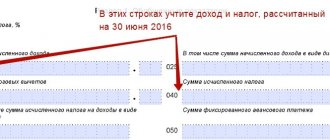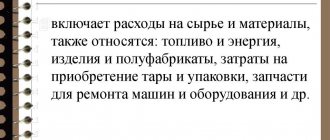Direct and indirect expenses in tax accounting
The Tax Code does not clearly define the terms “direct” expenses and “indirect” expenses.
However, from the wording of Articles 318 and 320 of the Tax Code of the Russian Federation, we can conclude that direct costs are those that have a clear connection with the process of production of goods (performance of work, provision of services). Indirect costs do not have such a direct connection. The composition of direct and indirect costs in each organization will be individual. It is necessary to determine a comprehensive list of direct expenses and consolidate it in the accounting policy.
Get a free sample accounting policy and do accounting in a web service for small LLCs and individual entrepreneurs
Expenses that are not specified in the accounting policy as direct will be considered indirect (clause 2 of article 318 of the Tax Code of the Russian Federation). At the same time, there is no need to divide non-operating costs into direct and indirect (clause 1 of Article 318, paragraph 3 of Article 320 of the Tax Code of the Russian Federation).
IMPORTANT. Only those organizations that operate on the accrual basis should distribute expenses into direct and indirect ones. Taxpayers who determine income and expenses using the cash method do not make such divisions.
Comparison
The main difference between direct and indirect costs is the degree of influence on the cost of products. Another criterion for the difference is the presence of an economic relationship with production facilities. Moreover, the same costs may be considered direct in some cases and indirect in others, depending on the specific stage of the production process.
For example, the costs of purchasing equipment for the production of goods will be direct in relation to the factory line (that is, they will have a close economic connection with it), but indirect in relation to the cost of producing the corresponding goods on this line.
The salaries of personnel who work in production will most likely be classified as direct costs. But remuneration for specialists from other departments of the company (accounting or, for example, the advertising department) is already an indirect expense.
Why, in principle, does it become necessary to classify a company’s expenses into direct and indirect?
In practice, this is most often due to the fact that such a division of costs is established in the provisions of Article 318 of the Tax Code and is used when determining the timing of crediting costs to reduce the tax base.
Those types of expenses that the Tax Code of the Russian Federation classifies as direct expenses can be reflected in tax reporting for the current period only as goods are sold. Indirect costs can be recorded in full in the relevant documents. But if the company provides services and does not produce goods, then both types of costs can be reflected in the same period. Thanks to this, the entrepreneur has the opportunity to use their constituent amounts to reduce the tax base at the same time.
Having determined what the difference is between direct and indirect costs, and also having considered what its practical significance is, we will record the conclusions in the table.
What are direct costs
Direct costs are those costs that can be attributed to specific goods, work or services. For example, in production these are usually the cost of raw materials and supplies, workers' wages, as well as depreciation of production equipment (machines, machines, workshops). In trade, direct costs can be considered the cost of goods and their delivery, insurance costs, customs duties and other transportation and procurement costs.
Check the financial condition of your organization and its counterparties
Direct costs of the enterprise
The classification of direct costs of an enterprise includes those expenses that can be easily attributed to a specific cost object (service, product, project).
Such costs include materials, raw materials that are directly used in the production of products, the cost of paying personnel directly related to the production of products. For example, for a company engaged in software development and maintenance, the costs of wages for the company's programmers are direct. Another example of direct costs can be piecework wages for working personnel.
Note 1
It must be remembered that in most cases in an enterprise, direct costs are variable, but there are exceptions. Typically, variable costs increase in proportion to the increase in output. This statement is true, for example, in relation to raw materials and supplies. However, the remuneration of the supervisor, who directly supervises production, will already be considered the fixed costs of the enterprise.
Too lazy to read?
Ask a question to the experts and get an answer within 15 minutes!
Ask a Question
What are indirect costs?
All costs that are not fixed in the accounting policy as direct and are not non-operating (clause 1 of Article 318 of the Tax Code of the Russian Federation) can be considered indirect.
ATTENTION. The decision about the impossibility of classifying a particular expense as direct (and, accordingly, recognizing it as indirect) must be made in each specific case, taking into account economically sound indicators and features of the technological process. This is explained by the regulatory authorities (letters from the Ministry of Finance dated 09.05.18 No. 03-03-06/1/63428, dated 03.13.17 No. 03-03-06/1/13785, dated 05.19.14 No. 03-03-RZ/23603 and the Federal Tax Service dated 02.24.11 No. KE-4-3/ [email protected] ), and the courts (decision of the Constitutional Court of the Russian Federation dated 04.25.19 No. 876-O).
List of indirect expenses for income tax
The Tax Code does not contain a clear list of indirect costs. The only expense that is directly named in the Tax Code of the Russian Federation as indirect is the depreciation bonus. This is recognized as part of the cost of a fixed asset, which is written off at a time during the period of putting the object into operation (clause 9 of Article 258, paragraph 2 of clause 3 of Article 272 of the Tax Code of the Russian Federation).
In practice, indirect costs are usually considered to be the salaries of management personnel and employees of departments not directly involved in production. This category of expenses also includes expenses for repairs and rental of non-production facilities, expenses for business trips or advertising. Depreciation on fixed assets that are not used to produce products (for example, office equipment, computers, furniture, vehicles intended for management personnel) is also an indirect expense.
Maintain tax and accounting records of fixed assets according to the new rules
Indirect costs of the enterprise
Definition 1
Indirect costs of an organization include those that cannot be attributed directly to any specific cost object, but they are associated with supporting the activities of the organization as a whole. An example of such costs is the overhead costs of the enterprise, which remain after excluding direct costs from the total amount.
An example of indirect costs of an enterprise can be administrative expenses, for example, rental of office equipment, utilities, communication services and others. While these cost elements make a direct contribution to the activities of the enterprise as a whole, they cannot be attributed to the production of any specific product. Also examples of this type of costs are commercial expenses for marketing and advertising, legal and consulting services, etc.
Indirect costs of remunerating employees of an enterprise make it possible to produce a cost object, but cannot be directly attributed to any specific product. For example, the costs of paying managers, accounting and human resources departments are necessary to maintain the organization's activities, but do not relate to the production of a specific type of product.
Too lazy to read?
Ask a question to the experts and get an answer within 15 minutes!
Ask a Question
Indirect costs, like direct ones, can be either variable or constant in nature. For example, fixed costs include rent for company office space, and variable costs for electricity and gas for auxiliary equipment.
Examples of direct and indirect costs (table)
Here are examples of the most common direct and indirect costs
| Direct | Indirect |
|
|
Fill out, check and submit your income tax return online for free
Classification of direct expenses
A generally accepted classification of expenses has been developed. Thus, direct costs consist of:
- material costs;
- labor costs;
- deductions from salary;
- depreciation costs;
- other costs that are associated with the main activity of the company.
Let's take a closer look at what these economic elements include. Material costs include the total cost of materials expended, with the exception of products of own production, and these are: basic materials, raw materials, purchased semi-finished products, components, fuel and electricity, spare parts, building materials, packaging materials and other auxiliary materials. Direct costs for material resources are reduced by the total cost of all returnable waste, such as: leftover raw materials, material resources that arise during the production of a product or service.
Labor costs include all wage payments at specified rates and established salaries, as well as incentives, bonuses, vacation pay and payment for unworked time.
Direct deduction costs include social security deductions.
The concept of depreciation charges usually includes the amount of depreciation of fixed production assets, intangible assets and other types of assets, such as temporary buildings, inventory containers, which are directly involved in the process of commodity production.
Other direct costs include: communication services, travel expenses, payment for cash management services and more.
Enterprises where production specializes in only one type of product, almost all expenses can be safely classified as direct expenses. Direct costs at most industrial enterprises are taken into account on the basis of progressive standards for the consumption of various types of resources. Depending on the type of management tasks, the classification of costs can be very, very diverse. The main management tasks include: cost calculation; calculation of expected income; planning; control and regulation of production. To solve each of the above problems, there is a specific classification of costs. Accounting for direct production costs makes it possible to easily calculate the cost of production. The increase in the share of these costs in the total cost affects the increase in the accuracy of cost calculations.
The following methods of accounting for production costs have been developed:
- custom;
- normative.
The first method is used in the case when a unit of product has its own characteristic properties, and the product itself is manufactured in separate batches. In this case, the object of accounting is specific orders for a batch or a unit of commercial products. Cost accounting, which is based on the calculation of individual processes, is carried out as follows: first, the cost of a unit of production for each process is determined, then the cost of all units of production is summed up and the total cost of the final product is calculated.
The normative method of accounting for production costs is based on the creation of a system of certain norms and standards. Based on them, a standard cost calculation is compiled and only those costs that are directly related to deviations from already established standards are taken into account. The actual cost is determined by adjusting the standard cost for all cost items.
Why is it necessary to separate direct and indirect costs?
You can recognize direct expenses that fall on goods, works, and services sold in the same period as expenses of the current period. This means that in most cases, direct expenses incurred in a quarter will not be fully taken into account when assessing profits for that period. The costs attributable to work in progress, balances of finished products in the warehouse, as well as to shipped but not sold products will remain unaccounted for (Clause 2 of Article 318, Article 319 of the Tax Code of the Russian Federation).
IMPORTANT. Direct expenses are written off gradually - as products, works, and services are sold. Indirect costs can be taken into account in full during the period of their implementation. There is no need to wait for implementation (clause 2 of Article 318 of the Tax Code of the Russian Federation).
Direct costs in the estimate
More detailed information about what is included in the direct costs in the estimate can be obtained from the methodological document in construction MDS81-35.2004. In addition, this document also contains a brief description of other estimated costs.
The definition of what direct costs are in the estimate was given in a simplified form above in the text. It should be noted that this definition is typical for all estimate forms: be it an estimate according to Form No. 4, a local resource estimate or another form of estimate documentation.
Figure 1 shows a diagram of direct costs, on the basis of which it becomes clear that direct costs include the following items in the estimate: wage fund (WF), operation of machines and mechanisms (EMM) and materials (MAT).
Figure 1. Composition of direct costs in the estimate
The wage fund is the total cost of wages of workers (ZPR) and machinists (ZPM). That is, in this case, this element of direct costs includes two items in the estimate.
It should also be noted that although the wages of drivers are part of the payroll, their cost in the estimate is taken into account as part of the cost of operating the machines. But in any case, this does not in any way affect the fact that this indicator is included in the direct costs in the estimate.
Remuneration for both workers and machinists is determined based on labor intensity. Labor intensity is the number of hours required to perform a particular type of construction and installation work. Labor intensity is measured in man-hours (man-hours).
In addition, this item of direct costs in the estimate has a characteristic feature, which is the distribution of costs depending on the category of worker. The fact is that in any price estimate form, in terms of the wage indicator, the category that a worker must have in order to carry out one or another type of construction and installation work in compliance with all construction standards and requirements is also indicated. The higher the worker's rank, the higher the wage rate.
The machine operating index (OMI) is calculated based on the time of use of machines, mechanisms and tools. Direct costs in the estimate in this article are determined on the basis of an indicator such as machine hours (or machine hours).
As a rule, the cost of operating machines is part of the norm from the collections of estimate standards GESN or FER. However, the methodological document MDS81-35.2004 mentioned above allows for the possibility of calculating this indicator as part of direct costs in the estimate using the calculation method or the method of resource-technological models. Of course, such calculations must be justified and justified by the relevant permitting documents.
The cost of materials is also an important item, which is included in the direct costs in the estimate. It is important to note that the cost of material resources must be included in the local estimate, estimate in Form No. 4, local estimate, act of work performed in Form KS-2 and in other estimate forms, regardless of who purchased these resources .
The need for materials is determined, as a rule, on the basis of the project for the facility. Also, the amount of materials for each type of work can be taken into account in the estimate based on the defective list, list of materials, etc.
The volume of materials required for the production of each individual type of work is measured in physical units, that is, in meters, kilograms, cubes, etc. Direct costs in the estimate include the total cost of all material resources from all prices in the estimate form.
Figure 2 shows an example of a price, based on which it is demonstrated what is included in the direct costs in the estimate. Most of the norms from the collections of estimated normative bases of GESN and FER have a similar structure.
Figure 2. Example of a quote with direct costs
In addition, it should be noted that direct costs in the estimate may include indicators of energy consumption when using electrical mechanisms during construction and installation work.
What is more profitable for the organization?
Obviously, it is more profitable for taxpayers to recognize as many expenses as possible as indirect. This will allow you to write off related expenses faster and reduce your current tax liability. However, as already noted, expenses must be divided by type justifiably, taking into account production technology. It is permissible to recognize one or another type of cost as indirect only if it really cannot be classified as direct. If an organization violates this requirement, it faces additional tax charges (rulings of the Supreme Court of the Russian Federation dated November 24, 2017 No. 303-KG17-17016 and dated September 19, 2018 No. 306-KG18-13685).
The exception is organizations engaged in the provision of services. They are allowed to completely write off both indirect and direct expenses during the implementation period (Clause 2 of Article 318 of the Tax Code of the Russian Federation). This means that, although such taxpayers must divide expenses into direct and indirect, they will not face any negative consequences of incorrectly classifying expenses as indirect.
ADVICE. These organizations can use the general principle of writing off direct expenses only in the period when services are sold, the cost of which includes these expenses. It is advisable to consolidate the chosen option for recognizing direct expenses when providing services in the accounting policy.
In conclusion, let us remind you that the correct division of expenses into direct and indirect will allow taxpayers not only to avoid claims from the tax authorities, but also to optimize current tax obligations.
Direct and other costs in estimates
Direct costs in the estimate include the cost of wages, machine operation and the cost of materials.
That is, in essence, direct costs in the estimate are the costs of resources necessary to produce a specific type of work. However, in addition to direct costs, the estimate also takes into account other costs. Other costs in the estimate include many cost items, ranging from overhead costs to the cost of paying various taxes and fees. Later in the article, both direct and other costs in the estimate will be discussed in more detail.








